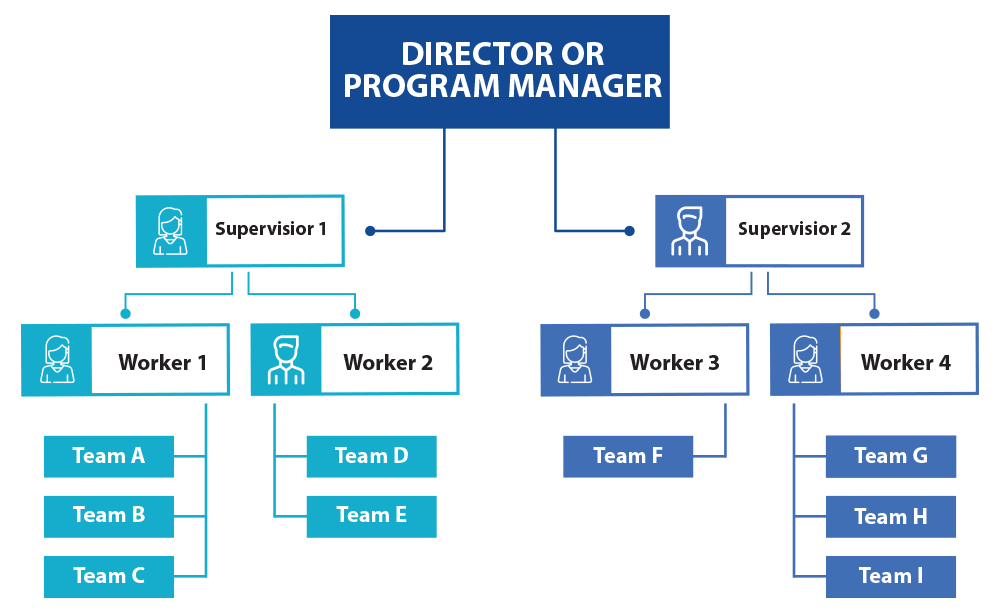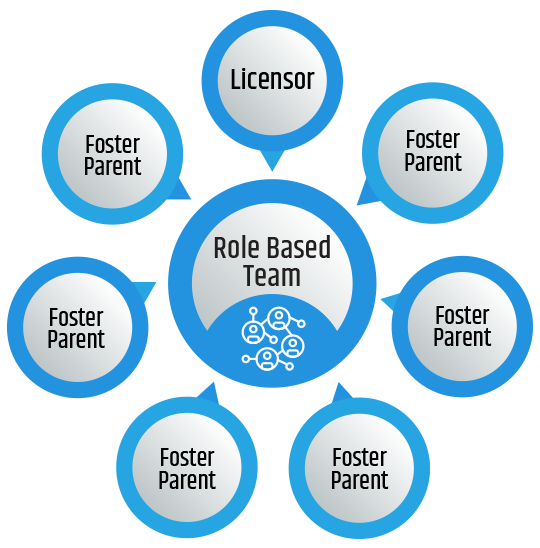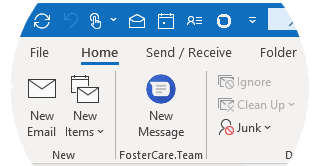Log in
For Agencies
The solution begins with communicationSM.
Does your agency have improvement goals for
caseworker and foster parent retention, streamlining communication, and improving foster parent support and recruitment?
If so, you've just found a powerful tool and vital resource that will help your agency accomplish these goals.
First, let's get some common misunderstandings out of the way:
- FosterCare.Team is not a social network site.
- FosterCare.Team is not a public foster care support forum.
- Using FosterCare.Team is not a HIPAA violation.
- FosterCare.Team does not duplicate SACWIS functionality. CCWIS rules allow for modularity so your agency can utilize FosterCare.Team.
FosterCare.Team is a web and mobile-based, team-centric, foster care collaboration platform that streamlines communication, improves foster parent support, and increases the quality of care for children in foster care. We allow foster care agencies to create teams, connecting foster parents, their caseworker, and everyone who works with the family's foster children. Software created efficiencies streamline communication between every member of a foster care team, providing a rich documentation trail while maintaining absolute team privacy and security.
While your agency certainly has tools to help your internal team communicate, FosterCare.Team is a tool that extends outside of your agency, to all the members of a foster care team such as mentors, GALs, counselors, foster parents and birth parents. By improving team communication, we improve foster parent support. By improving foster parent support, the foster children see improved quality of care. As an agency, you'll also find it easier to retain existing foster parents and recruit new ones because research has proven the most effective tool in recruiting new foster parents, is happy and supported existing foster parents. (That's your licensors cheering in the background.)
We also provide a secure and mobile-friendly digital signature solution and a video conferencing and webinar package that is enhanced with AI.
A Customer Testimonial
Unlimited users, unlimited signatures, and no per-user pricing. Those are three things you won't find with DocuSign or AdobeSign.
Our HIPAA compliant digital signature platform provides the most flexible and extensible electronic signature and document process workflow structure available on the market. From the simplistic to the most complex workflows, our transaction processing features and optional steps allow you to create the absolute optimal signing experience, including collecting signatures from mobile devices.
For less than the cost of postage and return postage, for less than the cost of mileage reimbursement and certainly more efficient than both of those options, FosterCare.Team's digital signature solution can efficiently collect legally-binding signatures and provide a detailed audit trail and evidence package of the entire collection process.
What support platform do you use for your foster parents? Prospective foster parents want to know they aren't alone. They want to know they'll be supported. National surveys show that up to 60% of foster parents quit during the first year. 40% of them cite poor caseworker communication and perceived lack of support from the agency as their primary reasons. Additional reasons include stress, inadequate training, and struggles dealing with grief and loss. These are the primary reasons foster parents give for quitting and FosterCare.Team is built to effectively addresses every one of them.
Learn how we can help address foster parent turnover.
A Customer Testimonial
Voice diction from their mobile device makes it quick and easy for foster parents to enter journal entries, track child behaviors, and log child emotions. Journaling allows the foster parents to provide others on the team a glimpse into the daily hum of their foster home. This results in a treasure trove of information to help counselors and caseworkers meet the needs of children and families.
It's also proven to be a safe, cathartic release for the stresses of daily life. Journaling allows foster parents to work through and process their thoughts and emotions. It's one of the primary tools psychologists offer to their clients who are experiencing grief, loss, stress, or anxiety.
At many companies, the productivity benefits of collaboration software have long been apparent; easy, efficient communication with colleagues, increased opportunities for brainstorming with remote team members, and the ability to share content, files and other resources with anyone, anytime, anywhere. Collaboration software has also been proven to increase transparency and lead to faster, more effective problem-solving. That's why businesses spend billions of dollars every year on collaboration tools. The problem is, until now, there wasn't a collaboration solution that was remotely close to a good fit for the foster care industry. That's why we created FosterCare.Team.
If you think FosterCare.Team is only a tool that allows foster parents to communicate with their caseworker, then you aren't seeing the full picture. We are much more than a foster parent portal. We're a collaboration platform that allows everyone on a foster care team to communicate with each other - easily and efficiently. FosterCare.Team can deliver the same collaboration benefits realized by big businesses while being tailored to the unique requirements of your foster care teams (like child behavior tracking and alerts for abuse and neglect disclosures). And when something is tailored specifically for you, the fit is always much better.

Will everyone see the files I upload and the posts I make? Everyone? As in "everyone" everyone? No. Access to your posts are limited to the members of the team the post was made in. Will everyone on the team see your posts? That's up to you. We encourage people to share knowledge freely with the other members of their care team. Yet, we recognize that sometimes a member of the team may have to post something extremely confidential that only they can see, or maybe only they and the caseworker can see. FosterCare.Team allows for that. All modules except the calendar module allow the poster to set the access privileges for whatever they are posting. By default, the post is visible to the entire team. Or, they can make the access level 'custom' and assign the specific people who are able to see the post, file, picture, note, etc..
FosterCare.Team was designed from the ground up with your foster care agency in mind. Relationships can be defined between caseworkers, supervisors, program managers and directors (or any of the custom roles you define for your agency). Those higher up in the organizational chart can see team information and dashboard statistics for everyone assigned below them in the organizational chart. In the example below, Caseworker 1 can only see their teams. They cannot see team information for Caseworker 2's teams. However, Supervisor 1 has access to both of their teams, but they do not have access to any of Supervisor 2's teams. It's not shown below, but Program Managers can report to a Director. The purpose of this structure is to silo the information and make sure only the people that need access to it, have it. If you maintain these relationships in another system, talk to us about integration possibilities.

Teams are the central point of our system. All information is collected at the "team" level. Teams are private and hidden and assigned to a specific agency. You can only see the teams that you have been given access to. You cannot search for other teams and ask to join them. A person may have access to multiple teams under multiple caseworkers. For example, from the graphic above, a counselor may have access to "Team B", "Team E" and "Team G".
The most common team is the "Managed Team". This team is typically created by a caseworker. It is usually a child-centric team; meaning the team members will include people directly working with a foster child. These might be a licensor, counselor, GAL, foster parents and at some point, possibly an adoption worker. It is at the caseworker's discretion on whom to invite to join the team. All members of the team have access to the journal entries, discussions, photos, comments, files, etc. for their team.
Some of our agencies create what they call "support teams" and "professional teams". These are different variations of a managed team. The support team is intended for the foster parent to be able to journal and vent and not have to moderate their comments because of who is on the team. The professional teams do not include the daily journals from the foster parents because the audience is different. For example, the birth parents could be members of the professional team and not the support team. For some agencies, the GAL may also be limited to this professional team.
The second type of team is a "Role-Based Team". These are teams that existing users have automatic access to based on their role in the system. For example, maybe your licensing group wants to create a team for "All Foster Parents". All users with the role of 'Foster Parent' within the agency would automatically have access to this team.


Role-based teams are useful for quickly disseminating training material, articles of interest, important dates to remember, licensing information, shared files and embedded training videos. Our Pages module even allows you to create your own web pages within your team. The content editor makes it simple to add and edit content on these pages.
While a team is initially created by a caseworker or a licensor, the team runs itself. For a standard foster care team, the majority of the information communicated will come from the foster parent. Then other team members can respond and react to what was provided to the team by the foster parent. Your agency is simply providing the tool that allows this communication and collaboration to flourish.
Isn't this extra work for our caseworkers? No. It actually saves them time by streamlining communication which increases their efficiency. Let's take this scenario:
Let's say there is an issue with a child and the foster parents call the caseworker (it probably goes to voicemail). They leave a message about an incident. The caseworker has to call the foster parent back and may or may not reach them. When they finally connect, the caseworker has to document what the foster parent says using whatever resource they have available at the time. Then they need to re-enter this information as case notes into their case management system. But wait, they should really get feedback from the therapist as well. So they place a call to the therapist and leave another voicemail. The therapist calls them back with questions. The caseworker doesn’t have the answers so they have to reach back out to the foster parent who eventually responds to the caseworker who then relays that information back to the therapist. Finally, the therapist responds with their feedback (over the phone of course) so the caseworker documents the portions they think are important and is able to load the therapist’s comments – well, some of them anyway – into the case notes.
Phew. That is exhausting, it takes a lot of time and it is not efficient for anyone. (And we wonder why caseworker turnover is 20% - 40% every year?)
Or, you could simply let the foster parent document everything in a journal entry when it's convenient for them. The caseworker reads it when it's convenient for them. The caseworker can copy and paste it into the case notes exactly as the foster parent spelled it out. Done. Easy Peasy. If feedback is required from a therapist, it may already be there. If not, just use our @mention ability to make sure the therapist sees the post. The caseworker is then notified when the therapist responds and can copy and paste their response.

Again, simple. Easy. Efficient. It is also more accurate because you have everyone saying everything in their own words. There is zero chance of anyone misrepresenting what someone else has said. Any clarification needed by the therapist can be handled between the therapist and the foster parent via the system so everyone can see it. The amount of work a caseworker has to do is reduced to about 2 minutes total for the reading, sending the @mention, copying and pasting. (Talk to us about the possibility of integrating with your case management system.)
We could go on and on with stories like this. We're sure you can also. It's time for caseworkers to stop being chasers of information and instead, let the information flow to them.
Here's something else to consider: a caseworker can read 250 words per minute and can type 50. They are 5 times more efficient at reading than they are at typing. Wouldn't you rather have them reading and a copying the documentation provided by other members of the team? At the same time, without any additional effort, FosterCare.Team is able to keep everyone on the team updated.
Another challenge caseworkers face is where to look for information. The information presented to a caseworker can be spread across multiple communication channels: voicemail, email, fax, text message, instant message, face to face, secondhand from someone else, etc.. Caseworkers have to comb through all of these communication channels, without forgetting or overlooking anything, to combine all of that information back into a single source document that only they see. Or, you can use FosterCare.Team as the communication hub and collector of team information. The caseworker now only has to check one source for complete information. Also, having commonly requested files available to your team members mean they access them without needing to request them from the caseworker.
FosterCare.Team can also reduce daily disruptions. As one caseworker told us, "This is going to save me 2 hours a day!" She went on to explain the almost daily calls she receives from a stressed out and struggling foster parent who, while she did have a challenging placement, also needed a place to vent.
"With FosterCare.Team, I can have her journal everything she needs to communicate with me. This will help her therapeutically and it won't lead to massive interruptions during my day. I can work more efficiently, she can journal when it's convenient for her, and I can read her journals and respond when it's convenient for me. It's a Win/Win!"
As another caseworker put it, "I'd rather put out smoke than a raging house fire." FosterCare.Team allows foster parents to provide their care team with essential details of their daily life which helps them provide interventions and get ahead of potential issues. Our caseworker told us, "I know more about the needs of your foster children than I do of all my other foster children combined." FosterCare.Team makes the caseworker more efficient and able to do a better job. They are better informed and better able to support foster families and foster children.

The task list keeps all of the team's tasks organized and visible. Important tasks are less likely to fall through the cracks and more likely to get done. This reduces frustration, improves support, and child welfare.
Without good communication, the relationship between a caseworker and foster parent becomes strained and could become adversarial. This simply adds more stress for two people that certainly don't need it. By simplifying the communication process and making it more efficient, we keep these relationships strong, collaborative, and team-oriented.

We are often asked, "Isn't this one more system our caseworkers will have to use?" Actually, it's replacing many different systems used for communication. It's allowing others to enter information firsthand, so the worker doesn't have to listen to a voicemail and translate the information into another system. We are dramatically simplifying their job. Right now caseworkers receive communication through multiple channels including email, email attachments, voicemail, text message, instant message, Facebook message, fax, etc.. It takes time to corral all that disjointed information. Does some of it get missed and slip through the cracks? Yep. Instead, all of that communication can go into one system. It's organized, searchable, and typically authored by someone other than the caseworker. This makes their job easier to manage and that is a good thing.
One of the biggest reasons caseworkers love FosterCare.Team is because it helps them do their job better and more efficiently. Caseworkers shouldn't have to be mind readers. The ability to effectively support a foster parent is directly related to the foster parent’s ability to communicate their questions, concerns, and emotions. By using FosterCare.Team, your agency is giving foster parents the tools needed to effectively communicate with their entire team. FosterCare.Team helps caseworkers better support foster parents and provide the best care possible for their foster children. It is also a very different system from what they are used to working with because FosterCare.Team focuses on the human element of their job. As essential as the SACWIS system is, caseworkers did not enter this profession to key data into SACWIS. They went into social work to make a positive difference in the lives of foster children, foster parents, and families. The primary purpose of FosterCare.Team is to help them realize this goal. This is the side of the job that feeds their soul.
A Customer Testimonial
Counselors love it because it allows them to get a glimpse of the foster child in the foster home. Reading the foster parents' journals helps them better prepare for the child's next therapy session. It also saves them time because they don't have to rehash the week with the parents because they already know how it went. They also love the behavior tracking abilities of FosterCare.Team. This 'real-time' information helps them deliver a therapy session that is highly relevant to the foster child, meeting their most urgent needs.
Foster parents love FosterCare.Team because it helps them realize they aren't doing this alone. Throughout our system, we track team member views. This tells the foster parent who has read their journal entries, discussion posts, and has seen the pictures they posted. As a foster parent, I can't put into words how important it was for us to see that the members of our foster care team were reading our journal entries. It meant they cared and they knew what we were going through. It meant we weren't alone and oftentimes, that is the most important message your team needs to communicate with the foster parents. With FosterCare.Team, you can do it simply by reading.
GALs love it because it allows them to get to know the foster children before actually meeting them. This completely changes the initial interaction between the foster children and their GAL. For example, imagine two GALs serving two different foster children. One walks in and introduces himself and asks the child how school is going. They reply, "Fine" and that's it. The other who has read the foster parent's journals walks in, introduces themselves and says, "I see you're taking gymnastics lessons. That sounds like a lot of fun. What can you tell me about it?" For the next twenty minutes, the child elaborates on everything that is going on in gymnastics, provides examples of tumbles and handstands and then talks about school, and recess, and lunch, and just keeps on talking.
I point out these examples out because this was our actual experience with our first two GALs. One was before we started using FosterCare.Team and the other was after. It completely changed the mood in the room, the child was at ease and the GAL was learning a lot about them in their own words. This can also happen when new caseworkers are assigned.

Want an example? How about one where the caseworker doesn’t have to do anything? Here’s a real-life example. One foster family was dealing with some significant bedtime behavior issues. They opened a discussion topic about it on FosterCare.Team. Within an hour, one of the children's counselors was able to reply with strategies. An hour later, the other counselor was able to see the problem, see the first counselor's reply, elaborate on it and offer some additional insights and steps they should take. Based on the discussion view history in FosterCare.Team, the foster parents knew their caseworker was in the loop so they didn't have to make a special email or call to her. So at their next therapy session, instead of finally talking about the problem they had been dealing with for a week, they were able to talk about the solution they had been using for a week and how it worked. Did you see what the caseworker and agency had to do to increase support for that foster family? Nothing other than providing access to FosterCare.Team. Shared support is a naturally occurring byproduct of team collaboration and it’s one aspect of the system that everyone appreciates.
The Agency dashboard is designed to give agency employees a summary view over all of the foster children, foster homes and foster parents they are responsible for. This is an especially useful tool for supervisors. The predictive analytics features of the dashboard allow agencies to quickly identify which foster children, foster parents, and foster homes are at the greatest need for support and the greatest risk for a placement disruption. The dashboard is also used to quickly answer questions like these:
- How many abuse and neglect disclosures where there last month and did the caseworkers follow up on them?
- Are my caseworkers reading the journal entries and discussion topics posted in their teams?
- Are my caseworkers interacting with members of the foster care team?
- Which foster children are really struggling with their placement?
- Which foster children have the most significant behavior needs?
- How are my foster parents doing? Which ones need more support?
- How is the quality of life in the foster home? Is it going well or is intervention needed?
- Are my foster parents engaged and providing child welfare updates?

FosterCare.Team recognizes foster parents, guardians, caseworkers, and others use our platform to share sensitive information and sometimes PHI. We want to make sure that information is safe and secure and viewed by people you have authorized to view it. We also want our agency partners to feel comfortable working with us, so we take steps required by HIPAA to protect your information. For example:
- We use banking level encryption to secure information while it's in transit between your browser and our web server (and back).
- Our website requires a username (your email) and a password for access.
- Each user has a unique identifier within our system.
- We monitor successful and unsuccessful logins.
- We store your IP address when visiting our site, when attempting to log in and when you finally do log in.
- Five failed login attempts within five minutes causes a temporary block on further login attempts.
- Once inside the system, page views and downloaded files are logged by user ID.
- After a period of inactivity, we will automatically log you out of the system.
- Our server facility is secured with badged data center access requirements.
- We do nightly server backups.
- We have a disaster recovery plan in place.
- Perpetual Security (we go above and beyond HIPAA requirements here)
- Daily, automatic & rebootless kernel updates
- Dual firewalls
- Brute Force Defence against automated, high speed, password guessing
- Virus Scanning
- Malware protection
- 24/7/365 Security Monitoring
- All employees and contractors are HIPAA trained.
- We have a privacy policy listed on our website.
Using FosterCare.Team is nothing like uploading information to a public social network site or even a file-sharing site. It doesn't matter how cute, funny or amazing your journal or picture is, nothing you post on FosterCare.Team will go viral.
 Most foster care agencies are extremely diligent regarding HIPAA compliance, and they should be because the cost of HIPAA violations can be up to $50,000 per record! Plus, securing PHI and ePHI is the right thing to do. While most agencies have great policies and procedures about how they manage and store that PHI once they have it, many agencies overlook how they collect that PHI from birth parents, foster parents, and others.
Most foster care agencies are extremely diligent regarding HIPAA compliance, and they should be because the cost of HIPAA violations can be up to $50,000 per record! Plus, securing PHI and ePHI is the right thing to do. While most agencies have great policies and procedures about how they manage and store that PHI once they have it, many agencies overlook how they collect that PHI from birth parents, foster parents, and others.
Typically, this information is transmitted to foster care agencies via email, text message, or even Facebook messages. The documents sent could include drug screen results, prescription information, mental health diagnoses, general health information, completed medical forms, etc. All of those items are considered PHI and all of those methods of communication are unsecured and sent without encryption in violation of HIPAA guidelines. Even if an agency uses a secure messaging solution to upload formal medical documentation, they're still missing the informal PHI that is included in unsecured, casual communication between caseworkers and others.
That's where FosterCare.Team steps in and offers a secure, encrypted method for communicating all information, including PHI. This can include casual communication or formal communication requiring digital signatures with a detailed audit trail and signature evidence package.
 With our Microsoft Outlook plugin, we make caseworker-initiated messages convenient, easy, and HIPAA compliant. It's accessible from a familiar system they use every day. A click of a toolbar button in Outlook allows agency employees to send secure, HIPAA compliant email and text message notifications. Furthermore, these notifications and their responses are all automatically recorded within the appropriate team. Like all our posts within a team, access permissions can be set for the entire team or only certain members of the team. This makes the entire communication thread HIPAA compliant, not just the initial send.
With our Microsoft Outlook plugin, we make caseworker-initiated messages convenient, easy, and HIPAA compliant. It's accessible from a familiar system they use every day. A click of a toolbar button in Outlook allows agency employees to send secure, HIPAA compliant email and text message notifications. Furthermore, these notifications and their responses are all automatically recorded within the appropriate team. Like all our posts within a team, access permissions can be set for the entire team or only certain members of the team. This makes the entire communication thread HIPAA compliant, not just the initial send.
$6,000 is the low-end cost it takes the state and your agency to recruit, license, and train two foster parents. Then they quit in less than a year and the time, effort, and money you spent licensing and training them walks out the door. The cost for FosterCare.Team is $600 per private agency per year. (State agencies have different pricing and integration options.)
If a single foster family is retained anytime within the next decade, the agency’s license cost has been covered for that decade.
Any additional retentions over the next decade are positive returns for your agency and foster children.
If you're like most foster care agencies, you're losing between 30% - 60% of your foster parents every year. According to the National Foster Parent Association, "as many as 60% of new foster parents quit in the first 12 months." Ouch!
We can help. Let's start by understanding why these foster parents are leaving. There are many reasons other than adoption that foster parents don't renew their licenses. The National Foster Parent Association suggests that 40% of those families leave foster parenting primarily because of inadequate agency support. Additional surveys reveal the biggest reasons include:
- Poor communication by the caseworker
- Struggling with feelings of grief and loss
- Inadequate training
- Being overwhelmed by the stress of parenting children who have suffered trauma
FosterCare.Team was designed to specifically address each of these turnover drivers. When your foster parents are supported, your foster parents are happy, and happy foster parents are less likely to quit. This means your highly trained assets will stay with your agency, gain experience, and work with you to meet the needs of your community's foster children. Research also proves that happy foster parents are by far the most effective recruiters of new foster parents. (That's your licensors cheering in the background again.)

You'll find our pricing is simple and flexible. As you can see, the return on investment is there in dollars and many other ways you can't measure in dollars.
There's more to see, including the modules for document sharing, task lists, calendars, and pages as well as how to set up an agency hierarchy and teams. For more information, or to see a demo beyond what you find on our tutorial pages, please contact us using the link at the bottom of this page.